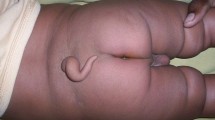Abstract
Lissencephaly (“smooth brain”) is a brain malformation characterized by a smooth cerebral surface, incomplete neuronal migration, and secondary abnormalities such as mental retardation, seizures, and minor facial dysmorphisms. Recent reports have produced evidence supporting several different causes including submicroscopic deletions in chromosome band 17p13.3, autosomal recessive inheritance, intrauterine infection, and intrauterine perfusion failure. We describe the clinical manifestations in seven patients with lissencephaly, and review pertinent studies regarding possible causes. The clinical manifestations were uniformly severe. All patients had severe mental retardation, hypotonia, often combined with spastic paralysis, and infantile spasms which did not respond to treatment. Most had poor growth, postnatal microcephaly, feeding problems, and frequent respiratory infections including pneumonia. None had other significant birth defects. Appropriate studies include computed tomography or magnetic resonance imaging (sometimes both), chromosome analysis, DNA analysis of the lissencephaly region on chromosome 17, electroencephalography and sometimes metabolic studies.
Similar content being viewed by others
References
Barkovich AJ, Koch TK, Carrol CL (1991) The spectrum of lissencephaly: report of ten patients analyzed by magnetic resonance imaging. Ann Neurol 30:139–146
De Rijk-van Andel JF, Arts WFM, Barth PG, Loonen MCB (1990) Diagnostic features and clinical signs of 21 patients with lissencephaly type I. Dev Med Child Neurol 32:707–717
Dobyns WB (1987) Developmental aspects of lissencephaly and the lissencephaly syndromes. Birth Defects 23:225–241
Dobyns WB (1989) The neurogenetics of lissencephaly. Neurol Clin 7:89–105
Dobyns WB (1989) Agenesis of the corpus callosum and gyral malformations are frequent manifestations of nonketotic hyperglycinemia. Neurology 39:817–820
Dobyns WB, Pagon RA, Armstrong D, Curry CJR, Greenberg F, Grix A, Holmes LB, Laxova R, Michels VV, Robinow M, Zimmerman RL (1989) Diagnostic criteria for Walker-Warburg syndrome. Am J Med Genet 32:195–210
Dobyns WB, Curry CJR, Hoyme HE, Turlington L, Ledbetter DH (1991) Clinical and molecular diagnosis of Miller-Dieker syndrome. Am J Hum Genet 48:584–594
Dobyns WB, Elias ER, Newlin AC, Pagon RA, Ledbetter DH (1992) Causal heterogeneity in isolated lissencephaly. Neurology 42:1375–1388
Hayward JC, Titelbaum DS, Clancy RR, Zimmerman RA (1991) Lissencephaly-pachygyria associated with congenital cytomegalovirus infection. J Child Neurol 6:109–114
Ledbetter SA, Kuwano A, Dobyns WB, Ledbetter DH (1992) Microdeletions of chromosome 17p13 as a cause of isolated lissencephaly. Am J Hum Genet 50:182–189
Pavone L, Gullotta F, Incorpora G, Grasso S Dobyns BW (1990) Isolated lissencephaly: report of four patients from two unrelated families. J Child Neurol 5:52–59
Author information
Authors and Affiliations
Rights and permissions
About this article
Cite this article
Pavone, L., Rizzo, R. & Dobyns, W.B. Clinical manifestations and evaluation of isolated lissencephaly. Child's Nerv Syst 9, 387–390 (1993). https://doi.org/10.1007/BF00306189
Received:
Issue Date:
DOI: https://doi.org/10.1007/BF00306189




